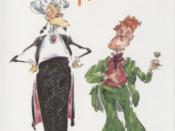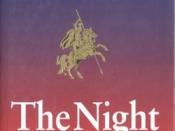The poem, Carpet Weavers,Morocco by Carol Rumens is written in four stanzas each comprising three lines. There is no noticeable rhyme scheme. Vocabulary and sentence structure are relatively straightforward with every line except the final two end stopped. Themes of Social injustice/poverty, Childhood and Work run through this poem.
There is an emphasis on colour in the first stanza. The bright colours of their dresses are contrasted with the black of their braids. ÃÂBraidsÃÂ is interesting as it highlights the childrenÃÂs youthfulness. Adults rarely braid their hair. The writer has chosen the word ÃÂbraidsÃÂ instead of the alternative ÃÂhairÃÂ. The hair could also be braided for safety.
The word ÃÂloomÃÂ (line 1) as a verb can have a negative connotation ÃÂ that of ÃÂto come into view as a massive, distorted, or indistinct image or to appear to the mind in a magnified and threatening formÃÂ. Is this referring to a fear of the future? Is the childrenÃÂs future frightening? There are many possible interpretations of this line.
ÃÂThe loom of another worldÃÂ could also refer to the nature of the carpet they are weaving since it is that of the garden of ÃÂIslamÃÂ.
The childrenÃÂs range of heights is described as ÃÂa melodious chimeÃÂ which relies on the sound as well as the image. Both images are pleasant and, indeed, the picture the poet paints here is at first glance pleasant.
Line 2 of this stanza emphasizes the fact that these are underprivileged children when they are said to ÃÂwatch their flickering knots like televisionÃÂ. These children are not children as we know them since they have already begun their working lives and are highly unlikely to have the luxury of wiling away hours in front of the television. This emphasizes the theme of social injustice. The word ÃÂtelevisionÃÂ seems somewhat out of place in this poem since it is describing a rather traditional way of life. The dedication they are showing to the carpet is compared to how we tend to be glued to the TV.
The third stanza focuses on the carpet itself and reinforces the idea that the children are working for a living by referring to the way that the carpet will be transported upon completion. This makes us realize that this is business and not pleasure. The third line of this stanza (line 9) has a double meaning since a carpet can be said to ÃÂgiveÃÂ when it yields under weight but can also have the more common meaning and in this sense it could refer to the benefits that children are likely to receive from prayer. It is interesting that the poet uses the abstract noun ÃÂheaped with prayerÃÂ rather than a possible ÃÂheaped with worshippersÃÂ.
The final stanza is interesting in that it is the only one which contains enjambement: all lines except the final two are end-stopped. The first line of this stanza begins with a repetition of ÃÂthe childrenÃÂ which links back to the first stanza. This line refers to the ÃÂschool of daysÃÂ and again reinforces theme of social injustice since these children do not have the luxury of a school education.
There is a great deal of alliteration in the final two lines which, with the added help of the final enjambed lines, speeds up the pace of the poem. The poet uses the ÃÂfÃÂ sound in ÃÂfrom their fingers the colours of all-that-will-be fly / and freeze into the frame of all-that-wasÃÂ (lines11-12). We see a sharp contrast between the movement of the verb ÃÂflyÃÂ and the stillness of ÃÂfreezeÃÂ and frameÃÂ perhaps referring to the life of children and the energy of youth as it advances until it is eventually captured (ÃÂframeÃÂ).
We see similar contrasts in ÃÂall-that will beÃÂ (line 11) and ÃÂall-that-wasÃÂ (line 12) again perhaps describing how the life of these children is already mapped out. There are many other possible suggestions.
BibliographyIGCSE English Literature teaching notes from Cambridge International ExaminationsÃÂReading PoetryÃÂ ÃÂ Myszor, F. Hodder and Stoughton: Scotland (2001)

